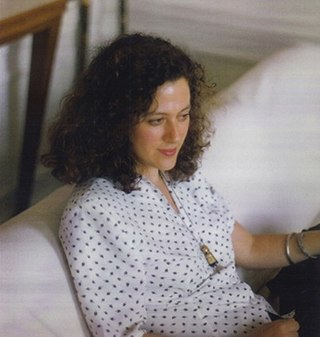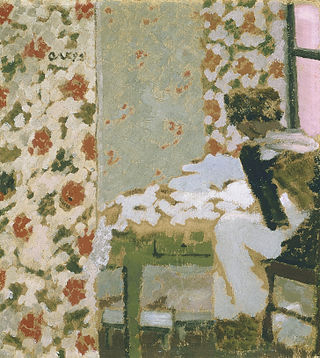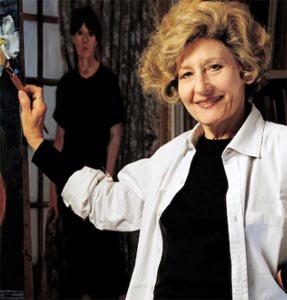
George Inness was a prominent American landscape painter.

Morris Louis Bernstein, known professionally as Morris Louis, was an American painter. During the 1950s he became one of the earliest exponents of Color Field painting. While living in Washington, D.C., Louis, along with Kenneth Noland and other Washington painters, formed an art movement that is known today as the Washington Color School.

Robert Indiana was an American artist associated with the pop art movement.
The Washington Color School, also known as the Washington, D.C., Color School, was an art movement starting during the 1950s–1970s in Washington, D.C., in the United States, built of abstract expressionist artists. The movement emerged during a time when society, the arts, and people were changing quickly. The founders of this movement are Morris Louis and Kenneth Noland, however four more artists were part of the initial art exhibition in 1965.

Alma Woodsey Thomas was an African-American artist and teacher who lived and worked in Washington, D.C., and is now recognized as a major American painter of the 20th century. Thomas is best known for the "exuberant", colorful, abstract paintings that she created after her retirement from a 35-year career teaching art at Washington's Shaw Junior High School.

Olive Rush was a painter, illustrator, muralist, and an important pioneer in Native American art education. Her paintings are held in a number of private collections and museums, including: the Brooklyn Museum of New York City, the Haan Mansion Museum of Indiana Art, the Indianapolis Museum of Art, Indiana and the Smithsonian American Art Museum.
Walter Darby Bannard was an American abstract painter and professor of art and art history at the University of Miami.
Sylvia Snowden is an African American abstract painter who works with acrylics, oil pastels, and mixed media to create textured works that convey the "feel of paint". Many museums have hosted her art in exhibits, while several have added her works to their permanent collections.
Williams is the first African American artist to be featured in The Janson History Of Art.
Kay WalkingStick is a Native American landscape artist and a member of the Cherokee Nation. Her later landscape paintings, executed in oil paint on wood panels often include patterns based on Southwest American Indian rugs, pottery, and other artworks.
Timothy J. Clark is an American artist best known for his large watercolor paintings of urban landscapes, still lifes, and interiors, and for his oil and watercolor portraits. His paintings and drawings are in the permanent collections of more than twenty art museums.

Herbert Vogel and Dorothy Vogel, once described as "proletarian art collectors," worked as civil servants in New York City for more than a half-century while amassing what has been called one of the most important post-1960s art collections in the United States, mostly of minimalist and conceptual art. Herbert Vogel died on July 22, 2012, in a Manhattan nursing home.

Lisa Bradley is an American artist who has been exhibiting for over forty years at galleries and museums in New York City, Washington, D.C., Los Angeles, San Francisco, Chicago, Boston, Paris, Helsinki, Tokyo, Brussels, and Dakar.

Alvin D. Loving Jr., better known as Al Loving, was an African-American abstract expressionist painter. His work is known for hard-edge abstraction, dyed fabric paintings, and large paper collages, all exploring complicated color relationships.

John Van Alstine is an American contemporary art sculptor and former assistant professor of fine arts at the University of Wyoming in Laramie and the University of Maryland in College Park where he taught drawing and sculpture. He primarily creates abstract stone and metal sculptures. His work has been exhibited in museums and galleries throughout the US, as well as Europe and Asia.

The Seamstress is an 1893 oil painting by French artist Édouard Vuillard, located in the Indianapolis Museum of Art, which is in Indianapolis, Indiana. It is a small, intimate image of a woman sewing.

Carol Brown Goldberg is an American artist working in a variety of media. While primarily a painter creating heavily detailed work as large as 10 feet by 10 feet, she is also known for sculpture, film, and drawing. Her work has ranged from narrative genre paintings to multi-layered abstractions to realistic portraits to intricate gardens and jungles.
Edda Renouf is an American painter and printmaker. Renouf creates minimalist abstract paintings and drawings developed from her close attention to subtle properties of materials, such as the woven threads in linen canvas and the flax and cotton fibers of paper. Renouf often alters these supports by removing threads from the weave of a canvas, or in her drawings, creating lines by incising the paper.

Walter Elmer Schofield was an American Impressionist landscape and marine painter. Although he never lived in New Hope or Bucks County, Schofield is regarded as one of the Pennsylvania Impressionists.

Clarice Smith was an American painter and portraitist whose paintings have appeared in a number of exhibitions in the United States and Europe. With her husband, Robert H. Smith, Clarice Smith engaged in philanthropy, especially at the University of Maryland, where the Clarice Smith Performing Arts Center is named for her, and at George Washington University, where the couple endowed the Smith Hall of Art. They also initiated a distinguished lecture series at the Smithsonian Museum of American Art.












